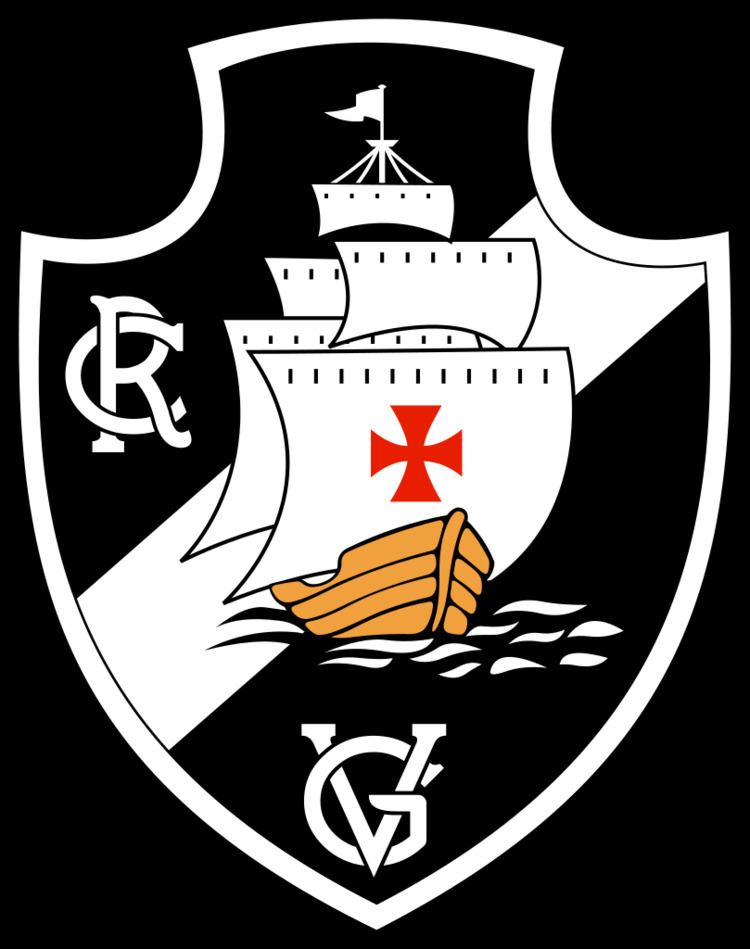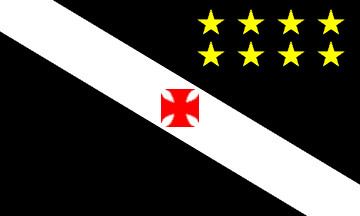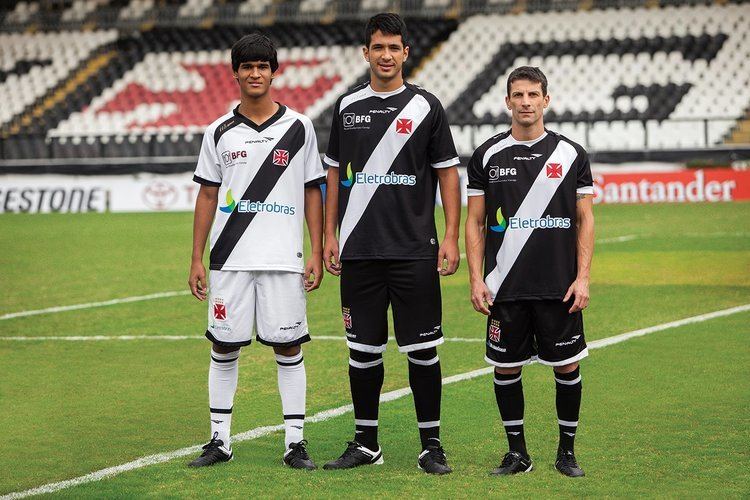Ground Capacity 21,880 | Football Manager Anderson Barros President Eurico Miranda | |
 | ||
Nickname(s) Gigante da Colina (Giant of the Hill)Almirante (Admiral)Cruzmaltino (Maltese Cross)Trem Bala da Colina (Bullet Train of the Hill) 2016 Série B, 3rd (promoted) Founders Henrique Ferreira Monteiro Profiles | ||
Club de Regatas Vasco da Gama ([ˈvaʃku dɐ ˈɡɐ̃mɐ], Vasco da Gama Rowing Club), usually known as Vasco da Gama, is a famous traditional Brazilian multisports club from Rio de Janeiro, Brazil. It was founded on August 21, 1898 (although the professional football department started on November 5, 1915), by Portuguese immigrants, and it is still traditionally supported by the Portuguese community of Rio de Janeiro. It is one of the most popular clubs in Brazil, with more than 20 million supporters.
Contents
- Foundation
- Fight and victory against racism
- The Victory Express and the South American Club championship
- 1969 Pels 1000th Goal
- 1998 Copa Libertadores
- 1998 Toyota Intercontinental Cup
- 2000 FIFA Club World Championship
- Copa Mercosur
- 2000 Copa Joo Havelange
- 2008 Campeonato Brasileiro
- 2009 Campeonato Brasileiro
- 2011 the Redemption Year
- 2012 Campeonato Brasileiro and Libertadores
- Other sports
- Current squad
- Reserve squad
- Out on loan
- Honours
- Statistics
- References
Its statute defines the club as a "sportive, recreative, educational, assistant and philanthropic non-profit organization of public utility".
Their home stadium is São Januário, with a capacity of 21,880, the third biggest in Rio de Janeiro (after Maracanã and Engenhão), but some matches (especially the city derbies) are played at the Maracanã (capacity of about 80,000). They play in black shirts with a white diagonal sash that contains a Cross pattée (famously, though mistakenly, identified as a Maltese cross), black shorts and black socks.
The club is named after the Portuguese explorer Vasco da Gama.
Foundation

In the late 19th century rowing was the most important sport in Rio de Janeiro. At this time, four young men – Henrique Ferreira Monteiro, Luís Antônio Rodrigues, José Alexandre d'Avelar Rodrigues and Manuel Teixeira de Souza Júnior – who did not want to travel to Niterói to row with the boats of Gragoatá Club decided to found a rowing club.

On August 21, 1898 in a room of the Sons of Talma Dramatic Society, with 62 members (mostly Portuguese immigrants), the Club de Regatas Vasco da Gama (Vasco da Gama Rowing Club) was born.

Inspired by the celebrations of the 4th centenary of the first sail from Europe to India, the founders chose the name of the Portuguese explorer Vasco da Gama to baptise the new club.

Football was included only with the fusion with Lusitania Clube, other mostly Portuguese immigrants club. Beginning in the smaller leagues, Vasco became champion of the league B in 1922 and ascended to league A. In its first championship in League A – in 1923, Vasco became champion with a team formed by whites, blacks and "mulattos" players of different social classes.
Fight and victory against racism
Football in Brazil back then was a sport for the elites, and Vasco da Gama's racially diverse squad didn't appease them. In 1924 Vasco da Gama was pressured by the Metropolitan League to ban some players that were not considered adequate to play in the aristocratic league, notably because they were black or mulato and/or poor. After Vasco refused to comply with such a ban, the other big teams, Fluminense, Flamengo and Botafogo, among others, created the Metropolitan Athletic Association and prohibited Vasco from participating unless it complied with the racist demands.
The former President of Vasco, José Augusto Prestes answered with a letter that became known as the Historic Answer (resposta histórica), which revolutionized the practice of sports in Brazil. After a few years, the racism barriers fell. Vasco da Gama had led the move toward a more inclusive soccer culture, forward-thinking not employed by leaders from Fluminense, Flamengo and Botafogo.
Even though the club was not the first to field black players, it was the first one to win a league with them, which led to an outcry to ban "blue-collar workers" from playing in the league - a move that in practice meant barring blacks from playing.
In 1925 Vasco was readmitted into the "elite" league, with its black and mulatto players. By 1933, when football became professional in Brazil, most of the big clubs had black players in them.
The Victory Express and the South American Club championship
Between 1947 and 1952, the club was nicknamed Expresso da Vitória (Victory Express), as Vasco won several competitions in that period, such as the Rio de Janeiro championship in 1945, 1947, 1949, 1950, and 1952, and the South American Club Championship in 1948. Players such as Ademir, Moacyr Barbosa, Bellini and Ipojucan defended Vasco's colors during that period.
1969 Pelé's 1,000th Goal
Pelé scored his 1,000th professional goal against CR Vasco on 19 November 1969, in front of 65,157 spectators. The goal, popularly named O Milésimo (The Thousandth), occurred in a match against Vasco, when Pelé scored from a penalty kick, at the Maracanã Stadium.
1998 Copa Libertadores
After winning the Campeonato Brasileiro in 1997, beating Palmeiras in the final, Vasco started its Projeto Tóquio, and invested US$10 million to win the 1998 Copa Libertadores. Vasco won the Copa Libertadores, beating Barcelona of Ecuador in the final.
1998 Toyota Intercontinental Cup
By winning 1998 Copa Libertadores, Vasco da Gama challenged the UEFA Champions League champion Real Madrid at 1998 Intercontinental Cup, in Tokyo, Japan. They lost the game 2–1.
2000 FIFA Club World Championship
By winning the 1998 Copa Libertadores, Vasco entered the inaugural 2000 FIFA Club World Championship held in Brazil. They beat Manchester United, Necaxa and South Melbourne in the group stage to reach the final, it finished 0–0 after extra time in an all-Brazilian clash with Corinthians but lost 3–4 in the penalty shootout.
Copa Mercosur
Also in 2000, Vasco won the Copa Mercosur against Palmeiras in a historical match. Losing 0–3 in the end of first-half, with Palmeiras scoring 2 goals in less than a minute. Vasco managed to score 3 goals and drew the game, 3–3. In the 93" Romário scored a decisive goal and Vasco won the match (4-3). Still today the match is considered the best game played in Brazil in history.
2000 Copa João Havelange
Vasco won the Copa João Havelange in 2000. Seen as controversial competition organized by Clube dos 13 rather than CBF, Vasco challenged São Caetano drawing the game by 1–1 when a disaster happened in São Januário Stadium. It won the second game beating São Caetano by 3–1.
2008 Campeonato Brasileiro
The team finished the championship in a disastrous 18th place and was relegated to the second division of the championship for the first time since its foundation, 110 years before. Up until the relegation, it was one of the only six clubs to have never been removed from the first division, along with Internacional, Cruzeiro, Flamengo, Santos and São Paulo, though the last two (even they never played any of the lower divisions), didn't participate in the 1979 Brazilian Championship's 1st division, in order to avoid conflicts with Paulista Championship schedule.
2009 Campeonato Brasileiro
After almost one year out of the first division, Vasco played the second division and on November 7, was promoted to the first division after a victory against Juventude in Maracanã stadium by the score of 2–1.
2011: the Redemption Year
After failing to win the Copa do Brasil, Vasco da Gama found success in 2011, lifting that year's trophy. Victory came against Coritiba in the 2011 Copa do Brasil final. Vasco came second in the 2011 Brazilian Série A, enjoying an excellent campaign. The club also ended the year as semifinalists in the Copa Sudamericana, a competition that saw the club defeat Palmeiras, Aurora and Universitario in historic fashion before being eliminated by Universidad de Chile, the other top two team in South America at the time. The season was dubbed the "Redemption Year of Vasco da Gama", with many lauding Vasco as one of Brazilian football's elite teams once again.
2012: Campeonato Brasileiro and Libertadores
In 2012, Vasco was a finalist in the two final rounds of the Campeonato Carioca, after beating Flamengo in the two semifinals. The main competition of Vasco in the year was the Copa Libertadores of America. After a good campaign the team was eliminated in the quarterfinals by Corinthians, with a goal at 43 of the second half. In the Brazilian Championship, the team set the record for 54 consecutive rounds in the G4 (counting Brazilian in 2011 and 2012), although they did not win the place for the Libertadores the following year.
Other sports
Although best known as a football, rowing and swimming club, Vasco da Gama is actually a comprehensive sports club. Its basketball section, CR Vasco da Gama Basquete (twice Brazilian champion and twice South-American champion) produced current NBA player Nenê. The club is also the first Brazilian club to play against a NBA team. In 1999, the club played the McDonald's Championship final against San Antonio Spurs. Its rowing team is one of the best of Brazil. Its swimmers regularly represent Brazil in international competitions. And Vasco da Gama is present in many other sports.
Current squad
As of 17 February 2017, according to combined sources on the official website.Note: Flags indicate national team as defined under FIFA eligibility rules. Players may hold more than one non-FIFA nationality.
Reserve squad
Note: Flags indicate national team as defined under FIFA eligibility rules. Players may hold more than one non-FIFA nationality.
Out on loan
Note: Flags indicate national team as defined under FIFA eligibility rules. Players may hold more than one non-FIFA nationality.
Honours
Unbeaten Champions
Statistics
Explanation:
